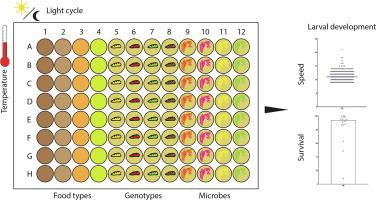Journal of Insect Physiology ( IF 2.3 ) Pub Date : 2020-08-09 , DOI: 10.1016/j.jinsphys.2020.104095 Laura Christin Trautenberg 1 , Oskar Knittelfelder 2 , Carla Hofmann 1 , Andrej Shevchenko 2 , Marko Brankatschk 1 , Elodie Prince 1

|
Metabolic research is a challenge because of the variety of data within experimental series and the difficulty of replicating results among scientific groups. The fruit fly, Drosophila melanogaster, is a cost-effective and reliable pioneer model to screen dietary variables for metabolic research. One of the main reasons for problems in this field are differences in food recipes, diet-associated microbial environments and the pharmacokinetic behavior of nutrients across the gut-blood barrier. To prevent such experimental shortcomings, a common strategy is to pool scores of subjects into one sample to create an average statement. However, this approach lacks information about the biological spread and may provoke misleading interpretations. We propose to use the developmental rate of individual Drosophila larvae as a metabolic sensor. To do so, we introduce here a 96-well plate-based assay, which allows screening for multiple variables including food quality, microbial load, and genetic differences. We demonstrate that on a diet that is rich in calories, pupation is sensitive to the variation of dietary lipid compounds and that genotypes considered as wild-types/controls produce different developmental profiles. Our platform is suited for later automation and represents a potent high-throughput screening tool for the pharmacology and food industry. If used systematically, our assay could become a powerful reference tool to compare the quality of used dietary configurations with published benchmark recipes.
中文翻译:

如何利用果蝇幼虫的个体发育作为代谢传感器。
由于实验系列中数据的多样性以及在科学团体之间复制结果的难度,因此代谢研究是一个挑战。果蝇果蝇(Drosophila melanogaster)是一种经济有效且可靠的先驱模型,可筛选用于代谢研究的饮食变量。该领域出现问题的主要原因之一是食品配方,饮食相关微生物环境的差异以及跨肠血屏障的营养素的药代动力学行为。为防止此类实验缺陷,一种常见的策略是将受试者的分数汇总到一个样本中以创建平均陈述。但是,这种方法缺乏有关生物传播的信息,可能会引起误解。我们建议使用个人的发展速度果蝇幼虫作为代谢传感器。为此,我们在这里介绍一种基于96孔板的检测方法,该方法可以筛选多个变量,包括食品质量,微生物负荷和遗传差异。我们证明,在富含卡路里的饮食中,化up对饮食中脂质化合物的变化敏感,而被视为野生型/对照的基因型会产生不同的发育状况。我们的平台适用于以后的自动化,代表了用于药理学和食品行业的强大的高通量筛选工具。如果系统地使用,我们的测定法将成为比较使用的饮食结构和已发布的基准配方质量的有力参考工具。











































 京公网安备 11010802027423号
京公网安备 11010802027423号